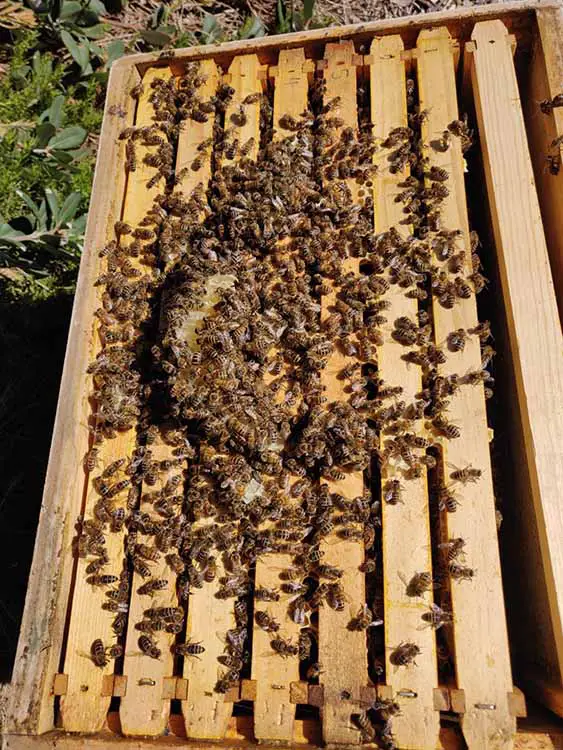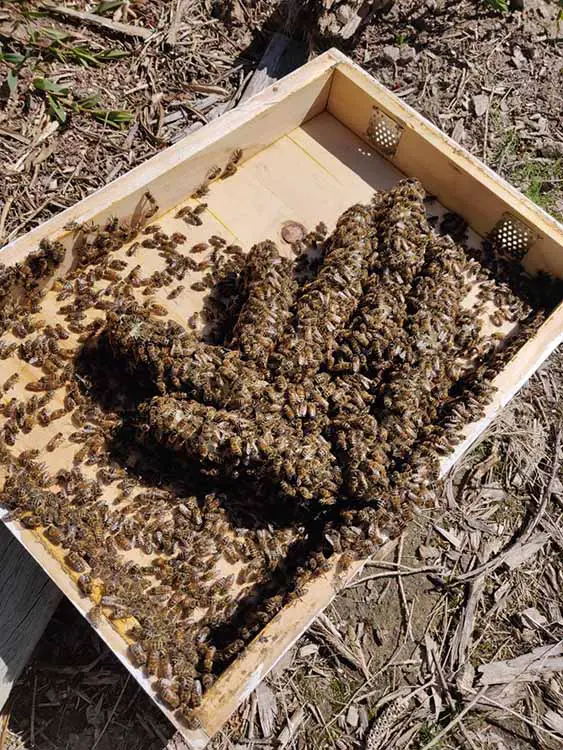Burr comb is comb built by worker bees between hive structures with a space greater than about 3/8 of an inch (or 1 centimeter) between them. Sometimes called bridge comb or brace comb, burr comb is built because it reinforces the strength of structures within the hive. Bees may also utilize burr comb to store honey, pollen, and brood.
Bees will even build burr comb on top of frames between the lid. This can signify the colony is running out of room inside the hive.
In general, spaces less than 3/8″ (1 centimeter) are cemented using propolis, whereas spaces greater than 3/8″ are joined by burr comb. The 3/8″ principle is known as ‘bee space’, because it is the distance bees will leave for themselves to move around the hive.
‘Bee space’ was first recognized and named by Reverend Lorenzo Langstroth in 1851, when he observed bees building comb in spaces greater than 3/8″. He invented the popular Langstroth hive in use today.
Burr comb can be a nuisance when you conduct a hive inspection, because it can make it difficult for you to remove frames and separate boxes for inspection. There will be occasions where burr comb won’t represent too much of an inconvenience to you as a beekeeper, however if your bees build cross comb then your hive inspections can become a lot more difficult.


What Is Cross Comb?
Cross comb is a type of burr comb too, so named because it’s the comb built by bees between the frames of a hive, in the opposite direction to the frames already in the hive. The comb is built between two frames like a bridge, effectively joining them together.
So if this happens in your hive, you’ll find it impossible to conduct your hive inspection without damaging the comb and killing some of the larvae and adult bees. Therefore, it’s better if you can avoid it in the first place.
As I’ve already mentioned, bees will manufacture comb where there is a space greater than 3/8″. So make sure there are no spaces greater than this between the hive structures.
If you use a Langstroth hive, the frames with wax foundation hang parallel to one another and the bee space is kept uniform, less than 3/8″. The workers will use the foundation to build comb, thus maintaining bee space between the frames.
Why Is Burr Comb Called A ‘Queen Killer’?
Burr comb is sometimes called a ‘queen killer’ because the queen can be at risk if she is using it to lay eggs. If you decide to clean away the burr comb, it’s possible the queen will be in there without you realizing.
If this happens, the queen may get injured or killed if you’re not careful. So make sure you always check burr comb for the queen if you’re going to remove it.
How To Avoid Burr Comb
The best way to avoid burr comb is by not allowing bees to make in the first place. This is easier to do if you are using a Langstroth hive, because all the components are standardized to create spaces no wider than 3/8″.
This means that after an inspection, if you push all the frames back together carefully, then you have created gaps that conform to bee space. However, if you aren’t so careful and some of the spaces are wider than 3/8″, then you may find burr comb being built the next time you conduct an inspection.
If you use a top bar hive instead of a Langstroth hive, then in the early days after introducing the bees, you will need to inspect the hive every few days to check that they aren’t building burr comb.
A top bar hive doesn’t have four-sided frames with wax foundation like a Langstroth hive does. It has bars across the top from which the worker bees build foundation. A new colony installed in a top bar hive may not build comb only from the top bars down, so it’s a good idea for you to inspect them every few days initially to remove any unwanted burr comb.
If you check them often in the beginning, you can remove the burr comb carefully before bees build too much and it becomes more difficult to remove. After being in the top bar hive for a year, the bees will be used to building comb from the top bars.
Should You Remove Burr Comb And What To Do With It?
Burr comb should be removed if it’s making it too difficult to inspect your hive. If you inspect your hive regularly during the warmer months you should be able to prevent a buildup of burr comb by removing it during inspection.
During Spring, when comb building is at its peak, you will inspect your hive every two to three weeks so you can remove burr comb then. Using smoke when inspecting your hives will help calm the bees and take their attention away from you.
I would especially remove the burr comb from the top and bottom of the frames each time because it will make frame and box removal easier. I use my hive tool to carefully remove burr comb.
Before doing so, I check to see no bees or queen bees in the comb. After removing the burr comb, I place it in a bucket and cover it with a towel or cloth so bees can’t get to it.
As I’ve said previously, if you carefully replace the frames so that bee space is maintained, you are less likely to have a buildup of burr comb in the first place.
How To Dispose Of, And Store, Burr Comb
When you remove burr comb, place it in a covered bucket until you have finished your hive inspection. Keep it covered so the bees aren’t able to get to the comb (as they’ll naturally be attracted to it).
Then, you need to remove it from the area. If you don’t, bees, wasps, ants, small hive beetles and larger pests such as mice will be attracted to it, and possibly your hive. You don’t want disease-carrying pests anywhere near your hive.
What If There Is Larvae Inside?
If you find the burr comb has larvae in it, then there are a few ways in which you can deal with it.
First of all, if it’s not making your hive inspections too difficult, you could leave it in place and wait until the larvae have hatched before removing it.
Secondly, you can attach it to a frame that has no wax foundation by using rubber bands. Place it in the hive and the bees will build comb around it and onto the frame over time. One day you will find the rubber bands outside the hive entrance because the bees no longer require them.
The other choice is to remove the comb anyway. The larvae in burr comb is often drone larvae and probably not as important as worker brood.
Remember, adjust your frames so that bee space is correct, and your burr comb issues will likely resolve themselves.
Other Burr Comb Uses
You can do several things with burr comb if you decide to remove it. Just make sure to keep the cleanest comb. If the comb has honey in it, I place it on the top of the frames to allow the bees to clean it up before I remove it from the hive.
Here are some other uses for burr comb:
- You can use a burr comb to encourage bees to draw comb in a new hive. You can shape the comb and then attach the burr comb (using rubber bands) to a frame with no wax foundation. The bees will attach the comb to the frame and then make a comb around it.
- You can use burr comb as a fire starter.
- You can save burr comb to make beeswax candles. Store the wax you collect in a zip lock bag in the freezer until you have enough to try candle-making.
- Use burr comb as a furniture polish. You can melt the wax and when cool, squeeze it into a ball which can be used to polish wooden furniture.
Can You Eat Burr Comb?
You can eat burr comb if you want to. The whole honeycomb is edible, even with larvae inside.
In some countries, bee larvae inside comb are seen as a delicacy. It is an excellent protein source and has a nutty flavor when cooked.
Bee larvae is not something I fancy, though I’m unlikely to ever try eating burr comb filled with larvae!
Final Thoughts…
Burr comb is built in man-made hives by bees when bee space (area between frames) is greater than 3/8″ (or 1 centimeter). Burr comb only becomes a nuisance when it prevents you from inspecting your hive properly.
To remove the burr comb or not is up to you. If you accurately maintain bee space between the frames within your hive, then it’s most likely something you won’t have to worry about too much.
However, if you do decide to remove the burr comb, there are many ways you can put it to good use!
